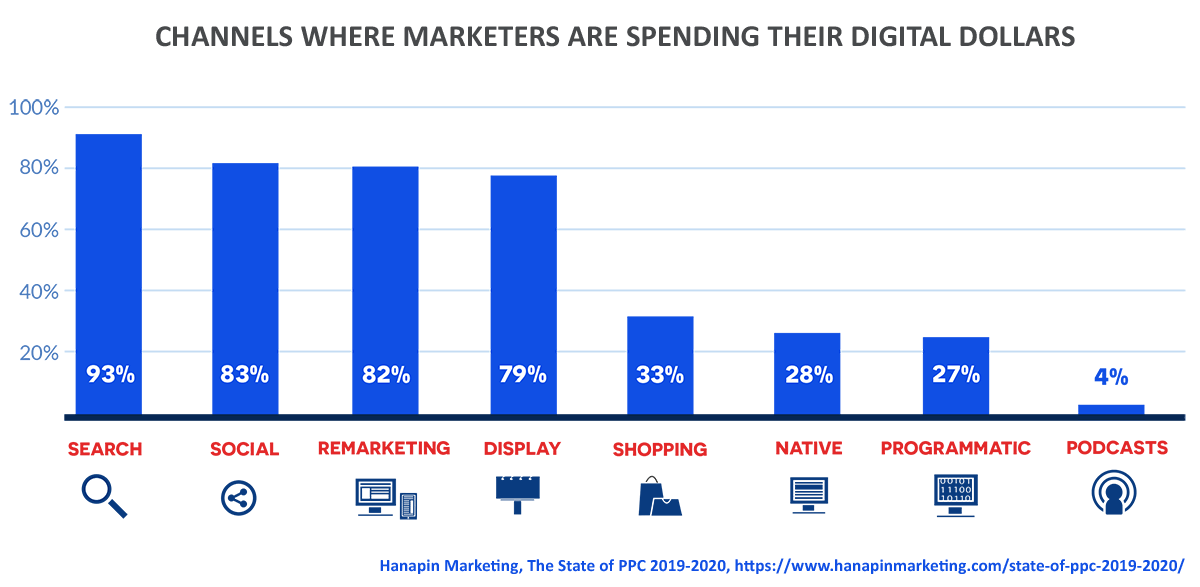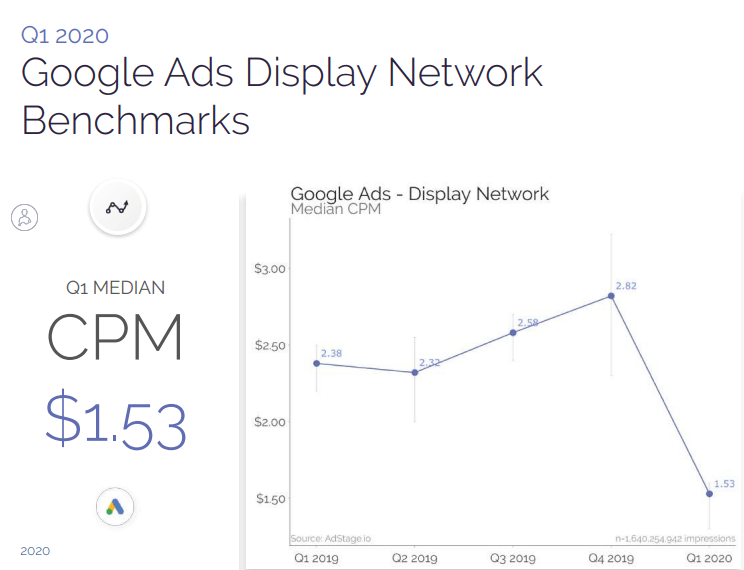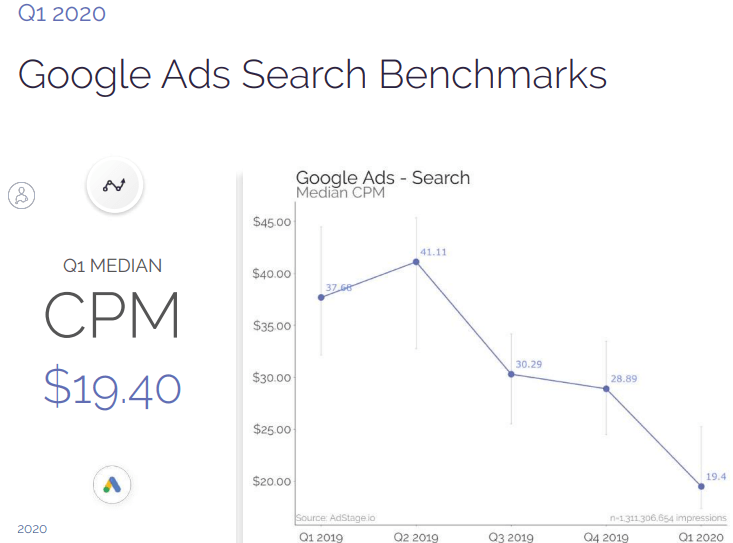A visitor enters your website, clicks on a product, and adds it to their shopping cart. But like millions of online shoppers, they don't complete the checkout.
Heck, some may not even make it past your product pages.
Does this signal dislike your product? Not necessarily.
In most cases, they're not ready to buy at that exact moment. If they're like many savvy online shoppers, they're either headed to a competitor's site to compare prices and features, or to conduct further research before making a decision.
Wherever they decide to go, you want to keep your brand top of mind. This is where Google ads remarketing comes in.
Let's review what Google ad remarketing is, its benefits, and how to make it work for your eCommerce business.
- What is Google ads remarketing?
- What are the benefits of Google Ads remarketing?
- What are dynamic remarketing Google ads?
- What are the options for Google Ads remarketing?
- How to create a remarketing campaign
- What is the cost of Google ad remarketing?
- 7 tips for building a remarketing strategy for Google Ads
- Start converting interested buyers into customers
Get brand new Google ad strategies straight to your inbox every week. 23,739 people already are!
What is Google ads remarketing?
Google ads remarketing is a campaign targeting past website visitors who left before purchasing.
It targets people based on their previous search terms, browsing history, location, device type, and other factors.
The goal here is simple: get them back into your funnel to increase the odds of conversion.
Companies are seeing (and finding) value in remarketing to customers. It's reflected in their ad spend:

Over 80% of marketers spend their money on remarketing campaigns, following close behind social media ads.
What are the benefits of Google Ads remarketing?
The most obvious benefit of Google ads remarketing is it potentially boosts sales. Of course, this depends on the strategies you implement. But in a campaign designed with best practices in mind, you could witness the following advantages:
Increase conversions
When you use remarketing, you're reaching out to past buyers, as well as new visitors. It's an excellent way to increase conversions from both ends of the spectrum to drive revenue. You can use it for both Google Search and Google Shopping ad campaigns. Just make sure to monitor and track conversions to weed out low-performing ad groups.
Boost brand awareness
The last thing any business wants is to lose its audience. With remarketing, you can prevent this. Showing targeted ads to people who browsed your products or services, will keep your brand top of mind (and one click away).
Control your budget (and reduce costs)
Running a remarketing campaign is cost-efficient for two reasons:
- You control how much you spend daily. And you're hyper-targeting interested buyers (a smaller group compared to targeting the masses).
- The total cost of your campaign depends on your daily budget and the number of clicks you receive. So it's critical to use personalized ads to reduce irrelevant traffic. There's also evidence that remarketing ads are cheaper than other paid methods.

For example, in Q1 2020, the median cost for Google Display ads was only $1.53 per 1,000 viewers. Pay-per-click (PPC) ads on Google's SERPs (search engine results pages) cost $19.40 to reach 1,000 people.

More targeted ad copy
Using the same generic ad for all of your site visitors...not a good idea. Instead, create highly targeted ad messaging that resonates with them specifically. Do this by designing campaigns around each audience type.
For example, someone comes to your website for the first time and clicks on an iPhone case. Their targeted ad should say something like:
"iPhone case for sale — 15% off when you sign up today!"
Now, you wouldn't want to show ads like this to a customer or subscriber, since it's irrelevant. They already signed up, so there's no way to capture the offer unless they do so with a new email. And that'll just dilute your email campaign metrics and results.
Drives impressive results
Consumers today are savvier—they see ads retargeting them, but some don't mind. In fact, they may even respond to them favorably if the timing is right. So consider using them for your standard and Smart Google Shopping ad campaigns.
The results we're seeing from clients vary depending on the traffic source. For example, if the initial ad that triggered remarketing was shown to someone on Facebook, then about 100% of that click is converted at a $0.75 CPL (cost per lead) and $1.25 ACoS (advertising cost of sales). However, if it's coming from Google search, we see about a 1.5x increase in ROI and a 40% decrease in CPL.
- Farhan Advani, Director Marketing of Buy Here Pay Here
What are dynamic remarketing Google ads?
Building remarketing campaigns for Google Ads is great, but throw in dynamics, and you have yourself a powerful tool to drive even better results. Dynamic remarketing Google Ads takes your campaigns to the next level by optimizing your ads for each user.
Let's say you own a dress boutique. A customer visits your site, looks at a black designer dress, then leaves.
Rather than displaying an ad with a generic dress and coupon, you showcase the exact dress they viewed. Dynamic remarketing ads automate this for you. It selects the image, price, and text of your choice to include in the ad.
That "text of your choice" should offer something enticing, like free shipping, or cross-selling a pair of shoes to go with the dress (at a discount) if they purchase today.
It improves the odds of the visitor returning and completing the transaction. But this is only one benefit of using dynamic remarketing ads. Here are several others:
- Scale your ads as your business scales by pairing your product feed with dynamic ads to display your entire inventory
- Easily add products to your feed using .csv, .xls, .xlsx., or .tsv files. Google's product engine will pull products from your feed and determine the best products for each ad based on its popularity and the visitors' past behaviors
- Display ads in the best layout based on the person, platform, and placement of the ad (for higher performance)
- Optimize bids in real-time using Google Ad's CPC and conversion optimizer to determine the best bid per impression
What are the options for Google Ads remarketing?
There are five options for setting up remarketing campaigns using Google Ads:
- Dynamic remarketing: Google uses your feed and creatives to customize the ads it displays
- Standard remarketing: Basic pre-made ads shown to your past website and app visitors via Google Display Network
- Video remarketing: Show video ads to people who engage with your YouTube videos, such as YouTube ads, or on Display Network videos and sites.
- Email list remarketing: Ads served to customer lists who are signed in to Gmail, Google Search, or YouTube.
- Remarketing lists for Google search: Ads shown to past visitors using the Search Network (Google and Google's Search partner websites).
How to create a remarketing campaign
To get started, create a new Google Ads account. Then choose which specific audiences to target. For instance, those who visited your website before, purchased items from your store, or viewed specific pages within your site.
You can also track users across devices and select whether you prefer standard (static) or dynamic ads. Standard ads stay the same, while dynamic ads allow Google to make changes to your creative every time you run them (based on user and product data). This means you can rapidly test different (and more) versions of your ads.
There are remarketing tags you must generate to track your ads. But you can avoid this step if you have a Google Analytics account. All you have to do is change the setting in the Admin to turn on Remarketing (Go to Admin > Tracking Info > Data Collection > Toggle on the remarketing button).
Here's a guide to setting up a dynamic remarketing campaign.
What is the cost of Google ad remarketing?
We discussed how Google remarketing ads are cost-efficient. But what can you expect to spend per campaign? It varies based on several factors, such as your:
- Bidding strategy: Actions you choose to pay for (i.e., signups, purchases, and other calls to action)
- Bid amount: How much you decide to spend daily for clicks, actions, and per 1,000 impressions
- Targeting: Are you targeting a broad or narrow audience? The wider the audience type, the higher the cost (due to more clicks)
- Ad schedule: What days and times your ads display (certain times have higher conversions and clicks than others)
- Landing page experience: An ad can be great, but if the landing page is confusing or doesn't meet their expectations, then you're wasting money on clicks
- Click-through rate (CTR): This represents the number of people who click on your ad, divided by those that viewed it
Here's a look at the average remarketing cost for this business owner (and his ROI):
My average spend is between $200 and $300 a month. We have been testing out 5 different variations of ads, have run the same ad for 2 months now as we test to see which performs best. Our ROAS varies from 90% up to as much as 250%.
- Farhan Advani
7 tips for building a remarketing strategy for Google Ads
Building a remarketing campaign can be a cost-effective way to drive more business to your company. But only if you're employing remarketing best practices.
Here are seven to keep in mind as you build your next campaign:
1. Create audience segments for your campaign
Look at your past conversions—who are your top customers? Use these insights to develop a new campaign with similar audiences and segments. This way, you can remarket to quality visitors more likely to convert. You can do the same for other events, such as email signups or shopping cart abandoners.
Also, consider excluding certain people, such as those who bounced or spent under 10 seconds on your site.
Segmentation, as with any marketing platform, is critical to campaign success. Segmenting your Google campaigns by-product is an effective technique to do so. Assume you run a prosperous online leggings store. Your present Google advertisements promote leggings in general, but not specific legging types.
Now imagine there is a potential customer on Google right now, searching for short yoga leggings' or leggings themed as 'Christmas leggings.' That astute shopper is unlikely to see your advertising, either because Google has deemed them irrelevant or because – if they are displayed – they are too generic to capture the interest of a shopper looking for something specific.
By segmenting your adverts according to product categories or styles and the accompanying keywords, you increase your chances of not only contacting potential buyers and directing them to your online store but also converting them. Why? Because this is critical to attracting highly focused customers to your store.
- Alexandra, Co-Founder and Creative Director at Miss Amara.
2. Set (reasonable) remarketing campaign goals
More conversions is the name of the game. But it's not the only goal businesses have. If you have other aspirations, such as increasing your number of email subscribers, then include this as one of your goals. This way, you can design ads, landing pages, and lead magnets to reach your objectives.
3. Always be testing your ads
Found an ad that converts well? Great! But it's no reason to stop testing other ad variations. Your winning ads can continue running, but they may not perform optimally forever. Experiment to learn the types of CTAs, offers, platforms, creatives, copy, and formats consistently drive results with your target audience.
This way, you have a foundation for building future ad remarketing campaigns.
4. Test and improve your landing pages
Don't just experiment with your ads. Try variations of landing pages too. A good rule of thumb is to create three versions of each page. Try switching out the title, offer, and CTAs. Maybe changing the color of your CTA buttons or shortening your copy will improve conversions.
Just make sure to use landing page best practices to ensure you're covering all your bases. And use this 37-point landing page checklist to help you along.
5. Target long-tail keywords
You don't need to focus solely on high-volume keywords when creating remarketing audience lists. Instead, find lower-competition long-tail keywords, which are three words or more. So instead of "used cars," you can target "used cars for sale." These phrases aren't necessarily popular search queries, but they could still generate quality traffic to your website.
6. Use negative keywords
Negative keyword filtering prevents irrelevant impressions. It's handy when you want to exclude specific terms that lead to wasted ad dollars.
Negative keywords work in tandem with broad match keywords. For example, if you sell shoes online, you might add "women boots" as a positive term while adding "men's boots" and "kid's boots" as negatives.
You should always review your list regularly to remove any outdated or ill-performing terms. Go to your Search Terms Report to see which keywords are driving irrelevant clicks and add them to your list.
7. Get the best bang for your buck
Your ad budget isn't large, but this won't stop you from bidding on as many keywords as you can.
Big mistake.
A common rookie error made by many online retailers is including an excessive number of keywords in their ads. The fewer terms you have, the more likely your Google Ads campaigns will be profitable.
Unless you're a giant company with hundreds of products, the basic rule is to keep your keywords to ten or fewer. This enables you to maintain a tight eye on your keywords to determine CPCs, while also ensuring advertisements that are triggered are extremely relevant, hence increasing your conversion rates.
- Daniel Foley, CMO at Scooter Guide
Spreading yourself too thin isn't the solution to driving better engagement and results. So rather than spending a few dollars on dozens of keywords, you're better off prioritizing the more profitable demographics, products, and markets.
This is why we promote building a single keyword ad group (or SKAG).
Why use this strategy? Because it ensures searchers see ads relevant to them. For example, if you have "kids boots, women boots, men's boots" all in one ad group, then your Google can't discern which to show.
So if it's someone looking for kid's boots, your ad could appear, but may display something like "winter boots." In turn, the searcher ignores your ad and continues scrolling.
By using the SKAGs approach, you can boost your click-through rates by offering specific and clear ads. Look for medium-traffic, low-competition keywords that match audience intent, and include them in your ad headlines.
Start converting interested buyers into customers
We've all done it before, and likely still do—searching for products for days (or even weeks) on end. And it's completely normal, especially for digital natives accustomed to "shopping around" online. So don't be deterred. Odds are, your visitors are looking to make a decision, but need a little nudge.
By displaying personalized Google remarketing ads, you can entice searchers to return and complete their purchases. But you need to create campaigns that convert. Hopefully, the best practices we shared help you do just that.
Meanwhile, if you're looking to build highly targeted Google Shopping campaigns, then check out our guide on Single Product Ad Groups.